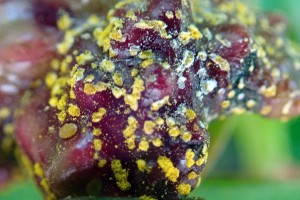Pathogen dynamics
We are focusing on understanding the behaviour of Austropuccinia psidii in its early invasion stages – a globally unique opportunity. A. psidii is known to reproduce by cloning itself (making multiple copies) but can also reproduce sexually. The sexual recombination of genes could increase the possibility that the pathogen will widen its host range, adapt to new climates, and resist control by chemical or biological means.
Working at North Island field sites – near Auckland, the Bay of Plenty, and Taranaki – our research centres on the hard-hit genus Lophomyrtus (which includes the species ramarama/bubble leaf and rōhutu). Using the latest genetic tools, we are monitoring how the pathogen evolves as it spreads across the study sites. We are looking for evidence of sexual reproduction, and monitoring disease progression.
Reproduction of the pathogen is also being studied under controlled conditions. We are carrying out experiments to investigate whether environmental conditions (including host resistance) can trigger sexual reproduction.
Research leaders



![Dr Michael Bartlett surveying a population of rōhutu [Neomyrtus pedunculata] – one of the native New Zealand species in the family affected by Myrtle Rust.](/assets/News/m-bartlett-scion__FillMaxWzMwMCwyMDBd.jpg)
